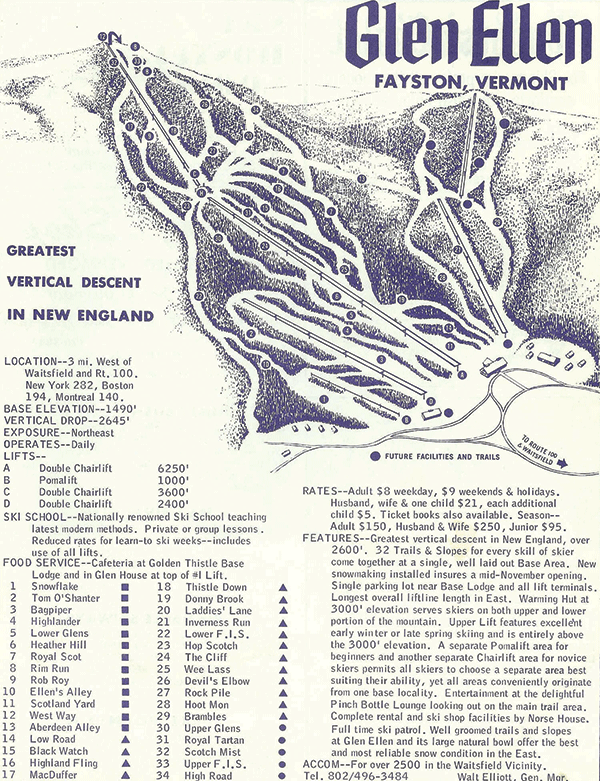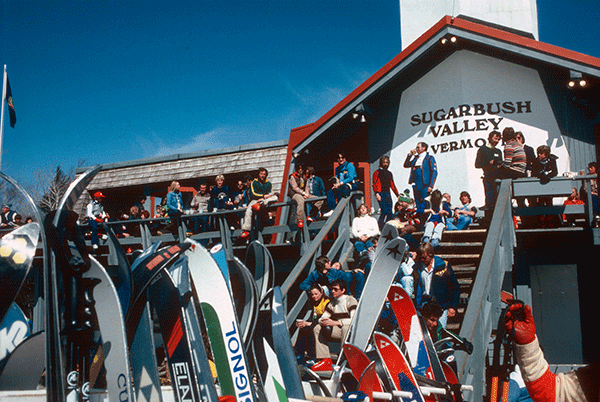Last week I wrote about Mad River celebrating its 75th anniversary. This week I’m writing about its immediate neighbor celebrating its 60th anniversary! That’s the Mt. Ellen portion of Sugarbush. In some respects this is the story of a lost Vermont ski area, or more accurately a lost and found Vermont ski area.
The original ski area was called Glen Ellen and was founded by Walt Elliot. Elliott was an engineer working at an acoustic tile company in New York City. He was also a skier and had been involved in building and running a ski lodge at Killington. But in 1961 he made the decision to change careers and build a ski area.
Elliott found Mount Ellen and felt it had great potential. He bought the land at the base and arranged financing by selling shares for $1500 that included 20 years of free skiing. He retained Bud Lynch who had been at Stratton to do the original Glen Ellen trail layout. Elliott struck a deal with local loggers to clear the trails in exchange for the lumber. Glen Ellen opened in December 1963.
It’s not clear how Elliott decided on the name “Glen Ellen” for the area. The nearby Glen Ellen Shelter on the Long Trail was built in 1933 so perhaps that inspired the name. I always figured that Walt Elliott was of Scottish descent since most of the trails had names with Scottish ties: Bagpiper, Black Watch, Inverness, Royal Tartan, and of course, Low Road and High Road! I was unable to confirm if this Walt Elliott was a direct descendant of an important Scottish politician with the same name, but it’s possible this influenced the choice of name.
The original lift structure had a long (6000+ feet) primary lift from the base and a lift above that went to the 4083 foot summit of Mount Ellen. With neighbor Sugarbush advertising the “greatest vertical rise in east” courtesy of its top to bottom gondola, Glen Ellen carried the “greatest vertical descent in east” slogan with its tiered chairlifts.
The summit lift had a couple of legitimate expert trails including one right under the lift called Scotch Mist, to answer last week’s trivia question. That trail was narrow and needed a lot of snow to cover rocks and things. Plus by being right under the lift it wasn’t a trail for introverts. When the conditions were right it was great! I had one of my most memorable runs ever in untracked powder on that trail.
The upper lift also allowed Glen Ellen to offer an extended season in the spring. I skied there in May several times.
In 1972 a lift accident on the long base lift was caused by a brake failure and resulted in serious injuries. A friend of mine and his wife were on that lift. When the lift began to accelerate in reverse, they were far enough up to plan a strategy. They got out of their skis and let them drop to the ground. They planned to jump out of the chair once it was lower to the ground near the base terminal. However enough chairs got jammed going around the bull wheel that the chairlift stopped before they had to jump.
Financial difficulties from the accident forced Walt Elliott to sell the area in 1973. In 1978 Sugarbush acquired Glen Ellen and it became “Sugarbush North.” In the 1980s Sugarbush made some much needed lift changes at North including the North Ridge chair which added more trails and allowed laps without having to go all the way to the base. They also invested in snowmaking coverage for the area.
Les Otten bought Sugarbush in 1994 and made a significant investment in new lifts at both South and North. This included the Slide Brook Express which connected the two areas. Before that they were only connected by shuttle buses. At some point in the 90s, the naming changed from Sugarbush South and North to Lincoln Peak and Mount Ellen.
By the way, the trail names have also changed from the Scottish Glen Ellen days. Scotch Mist is now called Black Diamond Rush!




Leave a Reply